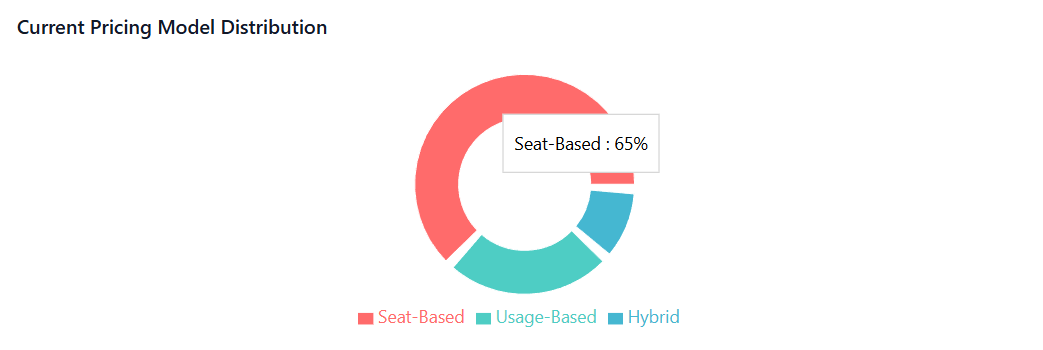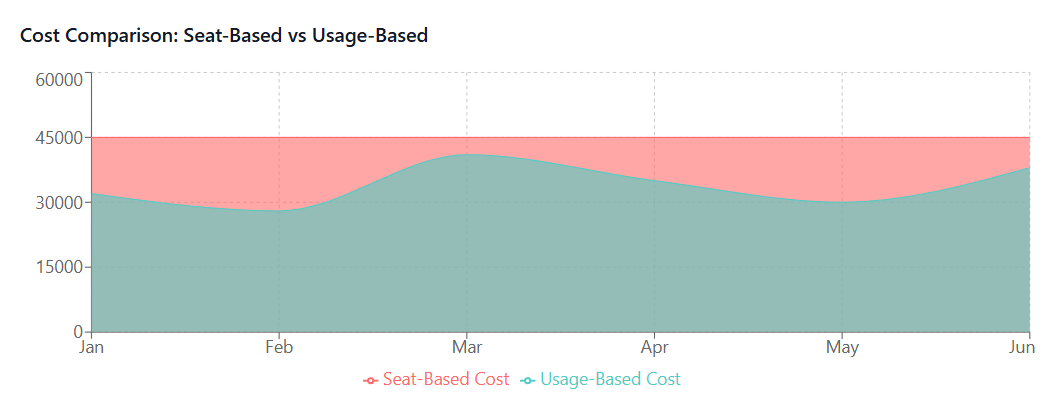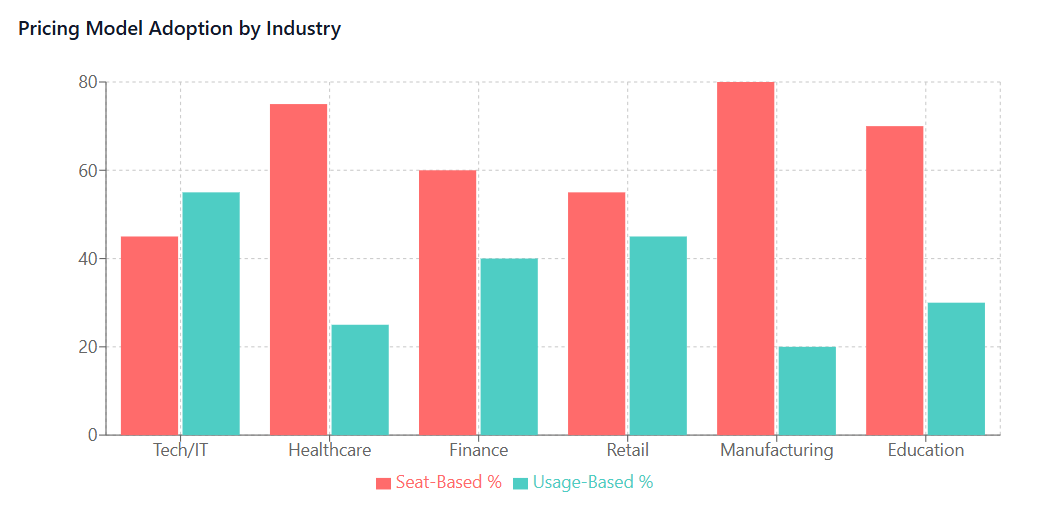
The Software as a Service (SaaS) landscape is undergoing a fundamental transformation in 2025, with organizations increasingly moving away from traditional seat-based pricing models toward more flexible, usage-based alternatives. This shift represents not merely a pricing adjustment but a strategic evolution that reflects changing business needs, remote work dynamics, and the demand for more equitable software costs.
As businesses become more cost-conscious and seek affordable SaaS solutions that align with actual consumption patterns, the transition to usage-based pricing has emerged as a critical component of modern SaaS spend management strategies. Understanding this transition is essential for organizations looking to optimize their software investments while maintaining operational efficiency.
Understanding Traditional Seat-Based Pricing Models
Seat-based pricing has long been the cornerstone of SaaS distribution, where organizations pay a fixed amount per user license regardless of actual usage intensity. Under this model, companies purchase software subscriptions based on the number of employees who might need access to the application, often resulting in overprovisioning to ensure availability during peak periods.
This traditional approach offered predictability and simplicity in budgeting, making it easier for organizations to forecast software expenses. Companies could easily calculate costs by multiplying the number of required seats by the per-user price, creating straightforward procurement processes that aligned with traditional software purchasing methods.
However, the seat-based model often led to significant inefficiencies. Organizations frequently paid for licenses that remained underutilized or completely unused, particularly for specialized applications where only a subset of users required regular access. This resulted in what industry experts call “software waste” – a phenomenon where businesses pay for capabilities they don’t fully leverage.
The model also created challenges for organizations with fluctuating workforce sizes, seasonal variations in software needs, or projects requiring temporary access increases. Companies found themselves either overpaying for unused capacity or facing restrictions when sudden scaling became necessary.
The Rise of Usage-Based Pricing Models
Usage-based pricing represents a paradigm shift toward consumption-driven software costs, where organizations pay based on actual utilization metrics rather than potential user counts. This model aligns software expenses with business value generation, creating a more equitable relationship between cost and benefit.
Under usage-based pricing, SaaS vendors track various consumption metrics such as API calls, data processing volumes, storage usage, transaction counts, or active user sessions. Organizations pay according to these measurable activities, creating a direct correlation between software utility and cost.
This approach has gained significant traction across various SaaS categories, from customer relationship management platforms that charge based on contact interactions to analytics tools that price according to data queries processed. The model particularly appeals to organizations seeking cost-effective SaaS solutions that scale proportionally with business growth.

The usage-based model addresses many limitations of seat-based pricing by eliminating the need to estimate user counts, reducing waste from unused licenses, and providing natural scaling capabilities that align with business expansion or contraction.
Key Advantages of Usage-Based Pricing
Enhanced Cost Efficiency
Usage-based pricing eliminates the fundamental inefficiency of paying for unused software capacity. Organizations can significantly reduce their SaaS costs by aligning expenses with actual consumption patterns, often resulting in 20-40% cost savings compared to traditional seat-based models.
This efficiency becomes particularly pronounced for organizations with variable software needs, seasonal businesses, or companies undergoing rapid changes in workforce composition. Rather than maintaining fixed license counts that may not reflect actual requirements, usage-based pricing provides natural cost optimization.

Improved Budget Predictability
Contrary to initial assumptions, usage-based pricing can actually enhance budget predictability when properly implemented. Organizations gain detailed insights into consumption patterns, enabling more accurate forecasting based on business activity levels rather than estimated user counts.
Modern SaaS management tools provide comprehensive analytics that help organizations understand usage trends, identify optimization opportunities, and predict future costs based on business growth projections. This data-driven approach to budgeting often proves more reliable than traditional per-seat estimations.
Scalability and Flexibility
Usage-based pricing naturally accommodates business growth and contraction without requiring license reallocation or renegotiation. Organizations can scale their software consumption seamlessly, paying only for actual utilization as business needs evolve.
This flexibility proves particularly valuable for startups, seasonal businesses, or organizations undergoing digital transformation initiatives where software requirements may change rapidly. The model eliminates barriers to software adoption and enables experimentation without significant upfront commitments.

Better Alignment with Business Value
Perhaps most importantly, usage-based pricing creates direct alignment between software costs and business value generation. Organizations pay more when they derive greater value from the software, and costs naturally decrease during periods of reduced activity.
This alignment encourages more thoughtful software utilization and helps organizations identify which applications truly contribute to business outcomes. The model promotes efficiency while ensuring that software investments directly correlate with business success metrics.
Challenges in Transitioning to Usage-Based Models
Cost Unpredictability Concerns
Despite potential benefits, many organizations worry about cost unpredictability under usage-based pricing models. Unlike fixed seat-based costs, usage-based expenses can fluctuate significantly based on business activity levels, creating budgeting challenges for finance teams accustomed to predictable software expenses.
Organizations must develop new approaches to cost forecasting and implement SaaS governance policies that include usage monitoring, budget alerts, and consumption controls to prevent unexpected expense spikes.
Complex Cost Tracking Requirements
Usage-based pricing introduces additional complexity in cost tracking and allocation. Organizations need sophisticated monitoring systems to track consumption metrics across different departments, projects, or cost centers.
This complexity requires investment in SaaS spend management tools capable of providing detailed usage analytics, cost attribution, and optimization recommendations. Without proper tracking mechanisms, organizations may struggle to understand their true software costs or identify optimization opportunities.
Vendor Lock-in Risks
Usage-based pricing models can create subtle vendor lock-in effects, particularly when switching costs include data migration expenses or integration complexities. Organizations may find it challenging to evaluate alternative solutions when current usage patterns are deeply integrated into business processes.
This risk requires careful consideration of data portability, integration standards, and exit strategies when selecting usage-based SaaS solutions. Organizations should maintain detailed documentation of usage patterns and ensure they retain control over their data and workflows.
Internal Change Management
Transitioning to usage-based pricing often requires significant internal change management, particularly for organizations with established procurement processes and budget allocation methods. Teams accustomed to fixed software costs may resist models that introduce variability.
Successful transitions require comprehensive training, clear communication about benefits and expectations, and gradual implementation strategies that allow organizations to adapt to new cost structures without disrupting operations.
Strategic Implementation Approaches
Hybrid Pricing Strategies
Many organizations find success with hybrid pricing approaches that combine elements of seat-based and usage-based models. These strategies might include base subscription fees with usage-based overage charges, or tiered pricing that transitions from per-seat to per-usage at certain volume thresholds.
Hybrid models provide cost predictability for baseline usage while enabling flexible scaling for additional consumption. This approach particularly appeals to organizations transitioning from traditional pricing models who need time to adapt to usage-based budgeting.
Gradual Migration Planning
Rather than wholesale transitions, successful organizations often implement gradual migration strategies that move specific applications or departments to usage-based pricing over time. This approach allows organizations to gain experience with new pricing models while minimizing disruption.
Gradual migration enables organizations to develop internal expertise in usage tracking, cost optimization, and vendor management under usage-based models before expanding to broader software portfolios.
Pilot Program Development
Implementing pilot programs with selected applications or departments provides valuable learning opportunities before broader adoption. Pilot programs help organizations understand the operational implications of usage-based pricing while developing best practices for cost management and optimization.
These programs should include clear success metrics, regular performance reviews, and documentation of lessons learned to inform broader implementation strategies.
Cross-Functional Team Formation
Successful transitions require collaboration between finance, IT, procurement, and business teams. Cross-functional teams ensure that all stakeholders understand the implications of usage-based pricing and contribute to implementation strategies.
These teams should establish clear roles and responsibilities for usage monitoring, cost optimization, and vendor management under new pricing models.
Cost Optimization Strategies for Usage-Based Models
Consumption Pattern Analysis
Effective cost optimization under usage-based pricing begins with comprehensive analysis of consumption patterns. Organizations must understand when, why, and how software is used to identify optimization opportunities.
This analysis should examine usage trends across time periods, departments, and business functions to identify patterns that inform cost reduction strategies. Regular consumption reviews help organizations adjust usage patterns to optimize costs while maintaining operational effectiveness.

Automated Usage Monitoring
Implementing automated monitoring systems helps organizations track consumption in real-time and identify cost optimization opportunities. These systems should provide alerts for unusual usage spikes, budget threshold breaches, and optimization recommendations.
Modern SaaS management platforms offer sophisticated monitoring capabilities that integrate with usage-based pricing models to provide comprehensive cost visibility and control.
Right-sizing Consumption
Similar to cloud resource optimization, usage-based SaaS requires ongoing right-sizing efforts to ensure consumption levels align with business needs. Organizations should regularly review usage metrics and adjust consumption patterns to eliminate waste.
Right-sizing involves identifying underutilized features, optimizing workflow efficiency, and implementing usage policies that prevent unnecessary consumption without impacting business outcomes.
Vendor Negotiation Strategies
Usage-based pricing models require different negotiation approaches focused on consumption terms rather than seat counts. Organizations should negotiate favorable usage rates, volume discounts, and consumption credits that provide cost protection.
Successful negotiations might include usage caps, predictable pricing tiers, or volume-based discounts that provide cost benefits as consumption scales.
Technology Infrastructure Requirements
Usage Tracking Systems
Organizations transitioning to usage-based pricing need robust systems to track and analyze software consumption. These systems must integrate with existing IT infrastructure while providing detailed insights into usage patterns and cost attribution.
Effective tracking systems should offer real-time monitoring, historical analysis, and predictive capabilities that help organizations optimize usage and control costs.
Integration Capabilities
Usage-based pricing models often require enhanced integration capabilities to track consumption across different systems and business processes. Organizations must ensure their technology infrastructure can support the data collection and analysis requirements of usage-based models.
This may involve implementing new APIs, data connectors, or middleware solutions that enable comprehensive usage tracking and cost allocation.
Reporting and Analytics
Comprehensive reporting and analytics capabilities are essential for managing usage-based pricing effectively. Organizations need systems that provide detailed consumption reports, cost analysis, and optimization recommendations.
These capabilities should support both operational monitoring and strategic planning, helping organizations understand their software consumption patterns and make informed decisions about future usage.
Security and Compliance
Usage-based pricing models may require additional security and compliance considerations, particularly when detailed consumption data is shared with vendors for billing purposes. Organizations must ensure their systems maintain appropriate data protection while enabling accurate usage tracking.
This includes implementing access controls, data encryption, and audit trails that protect sensitive information while supporting transparent billing processes.
Industry-Specific Considerations
Healthcare and Compliance
Healthcare organizations face unique challenges when transitioning to usage-based pricing due to strict regulatory requirements and patient data protection needs. Usage tracking must comply with HIPAA regulations while providing accurate consumption metrics.
Healthcare organizations should work with vendors who understand industry compliance requirements and can provide usage-based pricing models that maintain appropriate data protection standards.

Financial Services and Security
Financial services organizations require usage-based pricing models that meet stringent security and regulatory requirements. Consumption tracking must not compromise sensitive financial data or violate industry regulations.
These organizations should prioritize vendors with strong security credentials and compliance certifications that support usage-based pricing without introducing additional risk.
Manufacturing and Operational Technology
Manufacturing organizations often require usage-based pricing models that integrate with operational technology systems and support industrial IoT applications. Consumption tracking must align with production schedules and operational requirements.
This may involve specialized integration capabilities that connect usage tracking with manufacturing execution systems, quality management platforms, and supply chain applications.
Retail and Seasonal Variations
Retail organizations benefit significantly from usage-based pricing due to seasonal variations in software needs. However, they must implement consumption tracking that accommodates peak shopping periods and inventory cycles.
Retail organizations should negotiate usage-based contracts that provide flexibility during peak seasons while maintaining cost efficiency during slower periods.
Measuring Success and ROI
Key Performance Indicators
Organizations should establish clear KPIs to measure the success of their transition to usage-based pricing. These metrics might include cost per transaction, usage efficiency ratios, and overall software ROI improvements.
Regular KPI tracking helps organizations understand whether usage-based pricing is delivering expected benefits and identify areas for further optimization.
Cost Comparison Analysis
Ongoing cost comparison analysis between seat-based and usage-based models helps organizations quantify the benefits of their transition. This analysis should consider both direct cost savings and indirect benefits such as improved scalability and flexibility.
Regular comparisons help organizations refine their usage patterns and negotiate better terms with vendors based on actual consumption data.
Business Impact Assessment
Beyond cost metrics, organizations should assess the broader business impact of usage-based pricing, including improved operational flexibility, faster software deployment, and enhanced ability to scale operations.
These assessments help organizations understand the full value proposition of usage-based pricing and inform future software procurement decisions.
User Satisfaction Metrics
User satisfaction metrics help organizations understand whether usage-based pricing models meet end-user needs and expectations. This might include surveys about software availability, performance, and overall user experience.
Regular user feedback helps organizations optimize their usage patterns and ensure that cost optimization efforts don’t negatively impact user productivity or satisfaction.
Future Trends and Predictions
AI-Driven Usage Optimization
Artificial intelligence and machine learning technologies are increasingly being integrated into usage-based pricing models to provide automated optimization recommendations and predictive cost management.
These technologies can analyze consumption patterns, predict future usage needs, and automatically adjust resource allocation to optimize costs while maintaining performance. Organizations should expect to see more sophisticated AI-driven optimization tools in the coming years.
Blockchain-Based Usage Tracking
Blockchain technology may play an increasing role in usage-based pricing by providing transparent, immutable records of software consumption. This could help address trust and verification issues between vendors and customers.
Blockchain-based tracking systems could provide enhanced security, reduce disputes over usage metrics, and enable more sophisticated consumption-based pricing models.
Industry Standardization
As usage-based pricing becomes more prevalent, industry standards for consumption metrics and billing practices are likely to emerge. These standards could simplify vendor comparisons and reduce implementation complexity.
Organizations should monitor industry standardization efforts and consider how emerging standards might impact their usage-based pricing strategies.
Integration with Business Metrics
Future usage-based pricing models may integrate more closely with business metrics and outcomes, moving beyond simple consumption tracking to value-based pricing that aligns software costs with business results.
This evolution could create even stronger alignment between software investments and business value, helping organizations optimize their technology spending more effectively.
Binadox: Optimizing Usage-Based SaaS Management
As organizations transition to usage-based pricing models, effective SaaS spend management becomes increasingly critical. Binadox provides comprehensive solutions for managing usage-based SaaS deployments, offering detailed consumption tracking, cost optimization recommendations, and automated governance capabilities.
The platform’s advanced analytics help organizations understand their usage patterns, identify optimization opportunities, and negotiate better terms with vendors based on actual consumption data. With support for both traditional and usage-based pricing models, Binadox enables organizations to manage hybrid environments effectively while optimizing costs across their entire software portfolio.
Binadox’s automated monitoring and alerting capabilities help organizations avoid unexpected usage spikes and maintain budget control under usage-based pricing models. The platform’s comprehensive reporting features provide the insights needed to make informed decisions about software consumption and vendor relationships.
Conclusion
The transition from seat-based to usage-based SaaS pricing models represents a significant opportunity for organizations to optimize their software investments while gaining greater flexibility and scalability. However, successful transitions require careful planning, robust monitoring systems, and comprehensive change management strategies.
Organizations that approach this transition strategically, with proper tools and processes in place, can achieve significant cost savings while improving their ability to scale operations and respond to changing business needs. The key lies in understanding consumption patterns, implementing effective monitoring systems, and maintaining focus on business value creation.
As the SaaS industry continues to evolve, usage-based pricing models will likely become even more sophisticated, offering new opportunities for cost optimization and business alignment. Organizations that begin their transition now will be better positioned to take advantage of these emerging opportunities while building the expertise needed to manage usage-based software portfolios effectively.
The future of SaaS pricing lies in models that create true alignment between software costs and business value. By embracing usage-based pricing thoughtfully and strategically, organizations can transform their software investments from fixed costs into variable investments that scale with business success.

